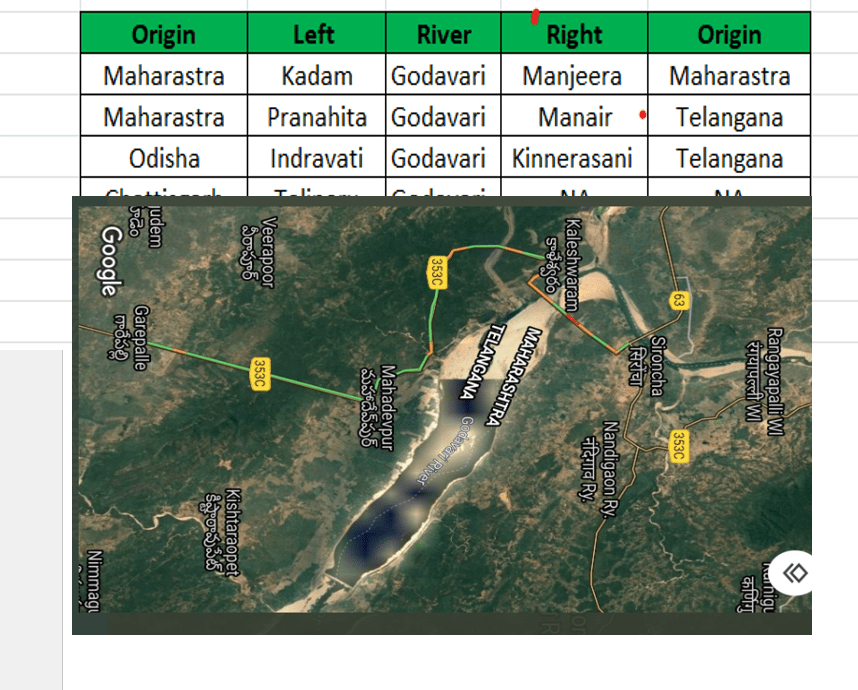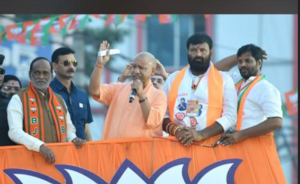Tributaries of Godavari in Telangana

Tributaries of Godavari in Telangana are the major reason for the huge water flow in the Telugu states than the actual Godavari itself. Because , the upper Maharastra State had built many Barrages and Dams on the River that the actual Godavari water only flows into the Telangana state during the Peak Monsoons. Rest of the year, the projects of Maharastra hold almost all the water and just few cusecs are released down the flow every week. Therefore, the Tributaries of Godavari in Telangana play a major role in filling the water levels in Godavari helping millions of lives in the state.
Godavari river in Telangana flows longer in length than Andhra but Telangana being high altitude region than Andhra, the river flows at lower level and much of land is at higher altitude than the river. This makes Andhra to have easy access to the Godavari water in their region where as most of the Godavari Basin in Telangana and surrounding regions need lift irrigation to have access to the water.
This is the main reason why the government of Telangana had built the world’s largest lift irrigation project ” Kaleshwaram” to pump the low lying Godavari water to the higher altitude regions of Telangana.

Tributaries of Godavari , their names – Importance, contribution of water, Geographical location, Projects on them etc…
| Origin | Left | River | Right | Origin |
| Maharastra | Kadam | Godavari | Manjeera | Maharastra |
| Maharastra | Pranahita | Godavari | Manair | Telangana |
| Odisha | Indravati | Godavari | Kinnerasani | Telangana |
| Chattisgarh | Taliperu | Godavari | NA | NA |
The Above are the Major tributaries with huge contribution of water to the main stream of Godavari. However, there are many small streams which contribute significantly but only in peak Monsoon like Raallavagu, Suddavagu, Haridra etc which merge with Godavari at respective places.
The above table talks about the names of the Tributaries, if they join the main stream at left bank or right bank, their actual origin etc. For Ex: Pranahita river takes birth at Maharastra and joins Godavari in Telangana at Kaleshwaram.
| Tributary | Merging point | Projects | Important places on banks |
| Kadam | Kadam Mandal , Nirmal Project. | Kadam Adi NarayanReddy project | Kadam Project |
| Pranahita | Kaleshwaram | Kaleshwaram project | Kaleshwaram |
| Indravati | Few miles below Kaleshwaram | NA | NA |
| Taliperu | Khammam Dist | Taliperu Project | Taliperu Project |
| Manjeera | Kandhakurthi | Manjeera, Singur,Nizam Sagar | Singur Dam, Manjeera, NizamSagar. |
| Maneru | Near Annaram Barrage | Lower, upper and Mid Maneru projects | Lower, upper and Mid Maneru projects |
| Kinnerasani | After Palvancha and Before badrachalam | KinnerasaniProject | Kinnerasani project |
Out of Above rivers, Kadam , Manjeera and Maneru play significant role in providing drinking and irrigation water to many cities.
Manjeera River
Manjeera river had played significant role in the history by providing drinking water to the Capital city ” Hyderabad ” for more than 3 decades. Manjeera flows at approximately 100KMS Northwest of Hyderabad in Sangareddy District.
It starts in Maharastra and enters into Telangana near NarayanKhed outskirts and flows through Sangareddy and Nizamabad districts making them more fertile and Agriculture rich districts of Telangana. Singur Project played crucial role in quenching the thirst of Hyderabad city for decades. Singur Dam is also one of the most visited tourist spot near Hyderabad.
Crocodile breeding centers are naturally found on the islands and banks of Manjeera River in these two districts. Manjeera Dam , Nizam sagar islands are best breeding spots for Crocodiles.
Aleru river (Pocharam Project ), Haridra River ( Small stream starts at Nacharam – Temple town 80 kms away from Hyderabad ) are two major tributaries of Manjeera River.
The River water is very fresh and regarded for it’s Taste and Color. Manjeera water was sold in Cans for Good amounts until Mineral treatment plants came up in Hyderabad.
Kadam River
Starts in erstwhile Adilabad Dist in thick Jungles. Flows through Nirmal and Merges with Godavari after Kadam project. Huge water of Around 40-50 TMCs of water is expected to join Godavari river mainstream every annual from Kadam River. Rest is served to Adilabad district through the canals of Kadam Project and this is expected to be more than 30 TMCs per year.
Maneru River
Upper Maneru Project built near Janagama town and this flows through Karimnagar and merges with Godavari near Annaram Barrage.
Maneru provides drinking water to Karimnagar, Jangama and serves thousands of acres through its Lower and Mid Maneru Projects.
Pranahita River
Pranahita and Indravati are the rivers which bring huge inflows into Godavari . However , the former joins Godavari at Kaleshwaram but the later joins the main stream further ahead. Since these points are almost at the borders of Telangana, though the stream becomes bigger -it doesn’t benefit the Telangana state much but Andhra Pradesh.
This is one of the main reason why Andhra bags huge water of Godavari than Telangana. Since this huge flow of water coming from Pranahita and Indravati join Godavari almost at the borders of Telangana , the water mainly flows in to Andhra instantly with out benefiting Telangana.
Government built Kaleshwaram to start pumping water of Pranahita -Godavari at Kaleshwaram back in to the river stream.
Therefore, Medigadda Project ( Lakshmi Project ) was built after the point where Pranahita merges with Godavari . The stored water is immediately uplifted by the Huge Bahubali motors and sent back to Saraswathi barrage (Water is uplifted and sent back to the stream.
Godavari in Telangana is still not the lifeline of state farmers unlike Maharastra or Andhra. This is purely because of lack of projects to hold the water and supply through canals . Since the land habitat is at much higher altitude than the river , the state decided to build lift irrigation project.
Though more than One lakh crores of rupees were spent so far on this Kaleshwaram Project, most of the canals connecting the river to different regions is not yet started.






